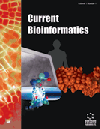- Home
- A-Z Publications
- Current Bioinformatics
- Previous Issues
- Volume 5, Issue 4, 2010
Current Bioinformatics - Volume 5, Issue 4, 2010
Volume 5, Issue 4, 2010
-
-
Graphical Representations of Protein Sequences for Alignment-Free Comparative and Predictive Studies. Recognition of Protease Inhibition Pattern from H-Depleted Molecular Graph Representation of Protease Sequences
More LessAuthors: Michael Fernandez, Julio Caballero, Leyden Fernandez and Akinori SaraiBiomacromolecular information is hinged by sequence and structure representations. Because structure is often more conserved than sequence, achieving function inference from structural similarity is easier than from sequence analysis. However, structural information is sparse and only available for a small part of the protein space. Detecting subtle similarities between proteins from sequence depends strongly on the re Read More
-
-
-
A Review of Methods and Tools for Database Integration in Biomedicine
More LessAuthors: Alberto Anguita, Luis Martin, David Perez-Rey and Victor MaojoThe post-genomic era, beginning at the end of the Human Genome Project, has led to new needs and challenges in the management of clinical and -omics data. One of the main issues in this new context for biomedical data management is the integration of heterogeneous sources, enabling access to different, remote biological data sources and the interpretation and discovery of new knowledge. Many researchers and practi Read More
-
-
-
Pre-Processing of Affymetrix Gene Chip Microarray Data
More LessAuthors: Ahmed R. Hasan, John E. Pattison and Alex HarizMicroarray technology has revolutionized biomedical research because it is now possible to concurrently determine the gene expression levels for the whole genome of a target organism. The accuracy of the computed gene expression levels is extremely important for the successful use of this technology. However, microarray gene expression measurements are inherently very ‘noisy’, meaning that appropriate techniques are r Read More
-
-
-
Microarray Data Integration: Frameworks and a List of Underlying Issues
More LessAuthors: Chintanu Kumar Sarmah and Sandhya SamarasingheMicroarray technology is expanding rapidly providing an extensive as well as promising source of data for better addressing complex questions involving biological processes. The ever increasing number and publicly available gene expression studies of human and other organisms provide strong motivation to carry out cross-study analyses. Besides, microarray technology provides several platforms to investigators that incl Read More
-
-
-
Network Building of Proteins in a Biochemical Pathway: A Computational Biology Related Model for Target Discovery and Drug-Design
More LessAuthors: Chiranjib Chakraborty, Sanjiban Sekhar Roy, Chi-Hsin Hsu, Zhi-Hong Wen and Chan-Shing LinWith the advances in bioinformatics, drug design strategies have been advanced with the focus on target discovery. ‘Proteins and enzymes’ target class represents potential drug target for different diseases. A networking of biochemical pathway of a disease and their drug target needs a thorough understanding. The accessibility of fully sequenced genomes, its total information and their product (proteins and enzymes) ha Read More
-
-
-
A Review of Ensemble Methods in Bioinformatics
More LessAuthors: Pengyi Yang, Yee Hwa Yang, Bing B. Zhou and Albert Y. ZomayaEnsemble learning is an intensively studied technique in machine learning and pattern recognition. Recent work in computational biology has seen an increasing use of ensemble learning methods due to their unique advantages in dealing with small sample size, high-dimensionality, and complex data structures. The aim of this article is two-fold. Firstly, it is to provide a review of the most widely used ensemble learning m Read More
-
Volumes & issues
-
Volume 20 (2025)
-
Volume 19 (2024)
-
Volume 18 (2023)
-
Volume 17 (2022)
-
Volume 16 (2021)
-
Volume 15 (2020)
-
Volume 14 (2019)
-
Volume 13 (2018)
-
Volume 12 (2017)
-
Volume 11 (2016)
-
Volume 10 (2015)
-
Volume 9 (2014)
-
Volume 8 (2013)
-
Volume 7 (2012)
-
Volume 6 (2011)
-
Volume 5 (2010)
-
Volume 4 (2009)
-
Volume 3 (2008)
-
Volume 2 (2007)
-
Volume 1 (2006)
Most Read This Month
Article
content/journals/cbio
Journal
10
5
false
en


